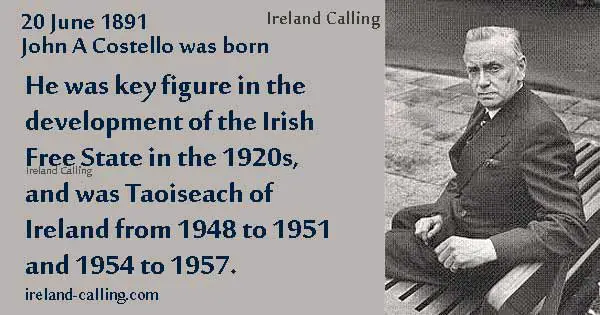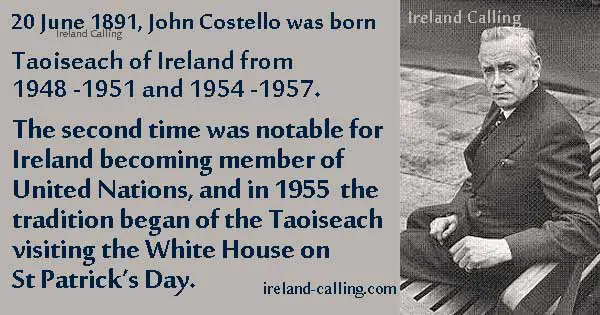John Aloysius Costello was the Irish Taoiseach (Prime Minister) who oversaw Ireland’s transition to a fully fledged, independent republic in 1948. He is also remembered as the man to took Ireland into the United Nations towards the end of his long and often controversial career. Despite being twice elected to the office of Taoiseach, he was a reluctant leader who never sought high office but rather had it thrust upon him by his colleagues.
Costello was born in Dublin on June 20 in 1891. He was a barrister and a key figure in the development of the Irish Free State in the 1920s. Costello was made Attorney-General to W. T. Cosgrave’s Cumann na nGaedheal government in 1926. Part of this role involved representing Ireland at League of Nations meetings with other world leaders.

He lost this position when Fianna Fáil won the 1932 election. However, he continued in public life the following year when he was elected to Dáil Éireann with Cumann na nGaedheal, the forerunner of Fine Gael.
Costello caused great controversy in 1934, with a speech he made criticising the government’s proposed hardline approach on the Blueshirts organisation. The Blueshirts were a right wing paramilitary group, similar to those in Germany and Italy, and loosely associated with the Fine Gael party.
The Fianna Fáil government, led by Éamon de Valera, wanted to ban the wearing of uniforms in an attempt to stifle the Blueshirts identity and cause. The same thing had been done by the Italian government to try and crush the Blackshirts movement, and in Germany with the Brownshirts, both of which were considered similarly dangerous right wing organisations.
Costello responded to the proposal with a lengthy speech, which raised questions about his own links with fascist movements. Here is an extract from the speech:
“The Minister gave extracts from various laws on the Continent, but he carefully refrained from drawing attention to the fact that the Blackshirts were victorious in Italy and that the Hitler Shirts were victorious in Germany, as, assuredly, in spite of this Bill…the Blueshirts will be victorious in the Irish Free State.”
He was wrong in this assertion as the Blueshirts failed to gain any real influence and soon faded from Irish life.
In 1948, the Irish public were becoming increasingly concerned about the poor state of the economy, as the country recovered from the deprivations of the Second World War. Fianna Fáil had been in power for 16 successive years, but still no other party could raise the support to topple them. The opposition parties decided to form a coalition government to finally force Fianna Fáil from power. On the face of it, this didn’t seem to be a workable solution, with several parties unlikely to be able to form a working government. However, the various parties were united by their dislike of Fianna Fáil, particularly its leader Éamon de Valera.
The coalition was formed and surprisingly it was decided that Costello should become the new Taoiseach. The obvious choice was the Fine Gael leader Richard Mulcahy, but he was unpopular with members of the smaller parties for his involvement in the Irish Civil War.
So Costello was chosen by his peers to be the new leader of Ireland. Privately, he didn’t actually want the job, happy with his current responsibilities as a practicing lawyer and part-time politician. He was talked into taking the job by his close friends and family.
His reign as Taoiseach was marked by the bill to declare Ireland an independent republic in 1948. Costello announced the bill during a dinner in Canada. Some theorists suggest he did this on the spur of the moment after being annoyed by the Governor General of Canada, who was of Northern Irish descent. The Governor allegedly placed symbols of Northern Ireland at Costello’s dinner seat, such as the Roaring Meg cannon that was used against the Irish in the Siege of Derry in 1689.
However, Costello’s official line was always that the Governor had been a kind and welcoming host, and had no impact on the decision, which had already been made. It was under Costello’s rule that Ireland finally became an independent republic when the Republic of Ireland Act 1948 came into force.
The Coalition government went to have a number of notable achievements, including the building of a record number of houses, the establishment of the Industrial Development Authority and advances in medical care, particularly in field of combating tuberculosis. Ireland also joined international organisations including the Organisation for European Economic Co-operation and the Council of Europe. However, the Coalition refused to join NATO while the British still occupied the six counties of Northern Ireland.
Costello lost his position as Taoiseach in 1951 when Fianna Fáil were returned to power. He remained as a TD but also began to concentrate more on practising law again. He was involved in a famous case in which the great Irish writer Patrick Kavanagh sued the newspaper, The Leader, for publishing images of him portraying him as a drunk. Costello defended The Leader and won the case. Despite Costello and Kavanagh being on opposing sides in the courtroom, the two men became friends.
Costello returned as Taoiseach in 1954, again as the leader of a coalition government. Ireland was struggling economically, with many of the country’s young skilled professionals leaving for better pay and prospects elsewhere. Costello’s second stint as Taoiseach was notable for Ireland becoming a member of the United Nations in 1955.
In 1956 he visited the United States and was invited to the White House by President Eisenhower. This was the start of the long-standing tradition of the Taoiseach visiting the White House on St Patrick’s Day. It is still in operation today and gives Ireland a regular contact with the President of United States that is afforded to no other small nation.
Costello only remained in power for three years before he called a general election after several of his peers had stated their lack of confidence in the current government. Costello had lost his wife a year earlier, and many thought he had become too tired and old to be leader of the country. He declined to stay on as Leader of the Opposition and retired to the back benches. He also continued his career as a barrister. He retired from politics in 1969 and was replaced in his Dublin South-east constituency by Dr Garret Fitzgerald, who would also become Taoiseach.
Costello died on 5 January, 1976 at the age of 84.
He had been a reluctant Taoiseach who never sought the highest office, but presided over Ireland progressing from a Free State still linked to Great Britain to a fully independent republic, albeit the six counties of the north still remained as part of the United Kingdom.

* * *